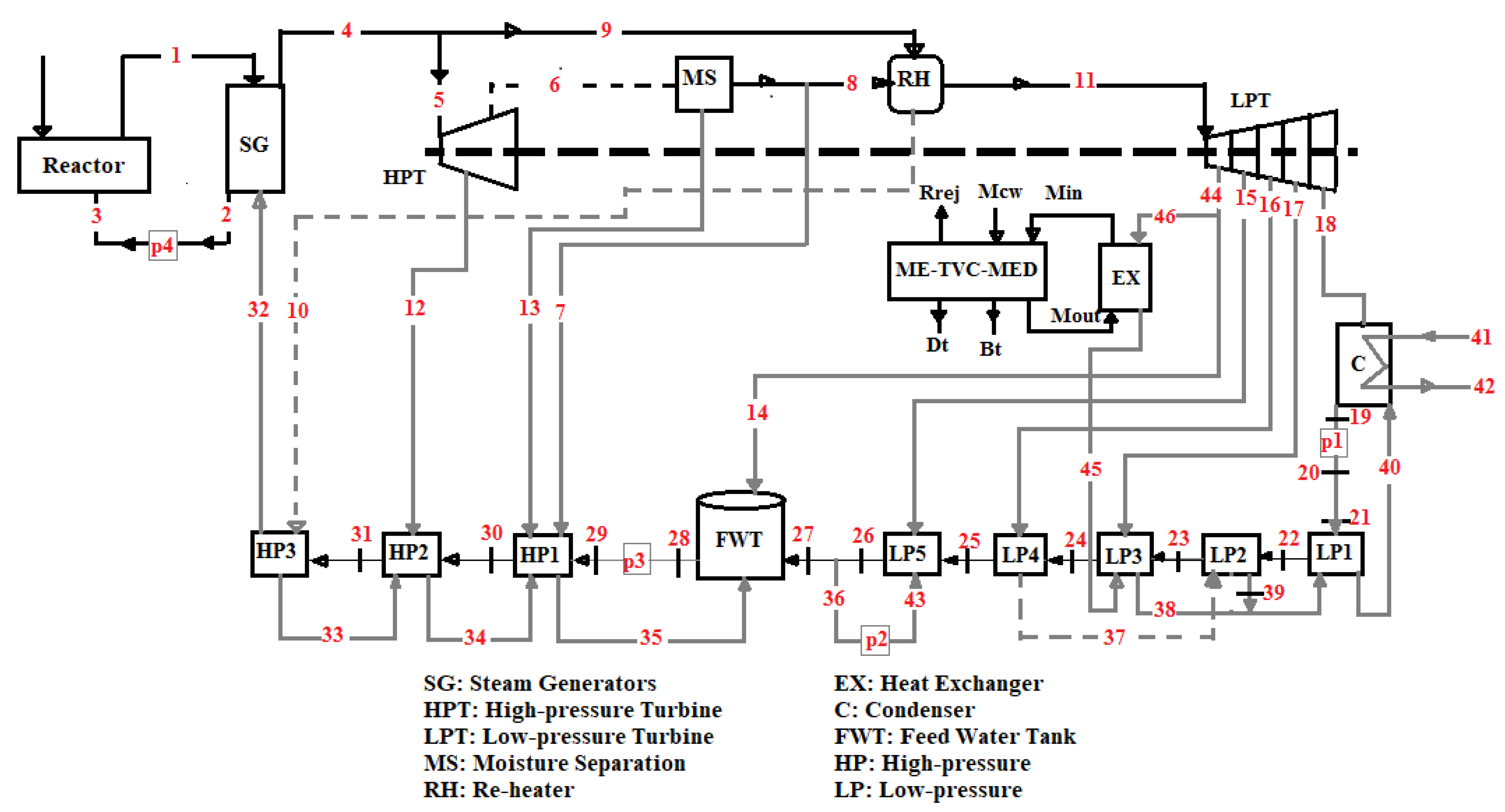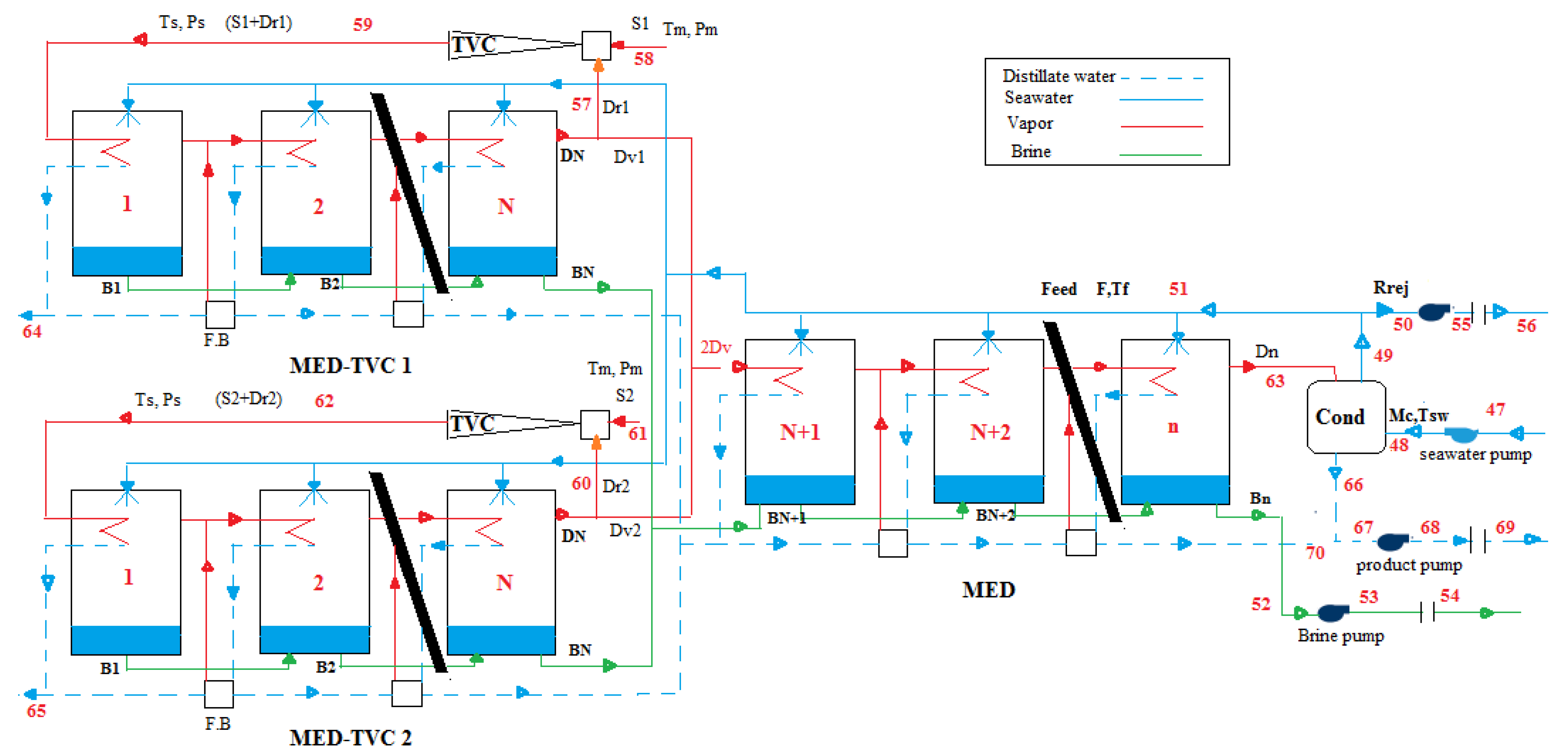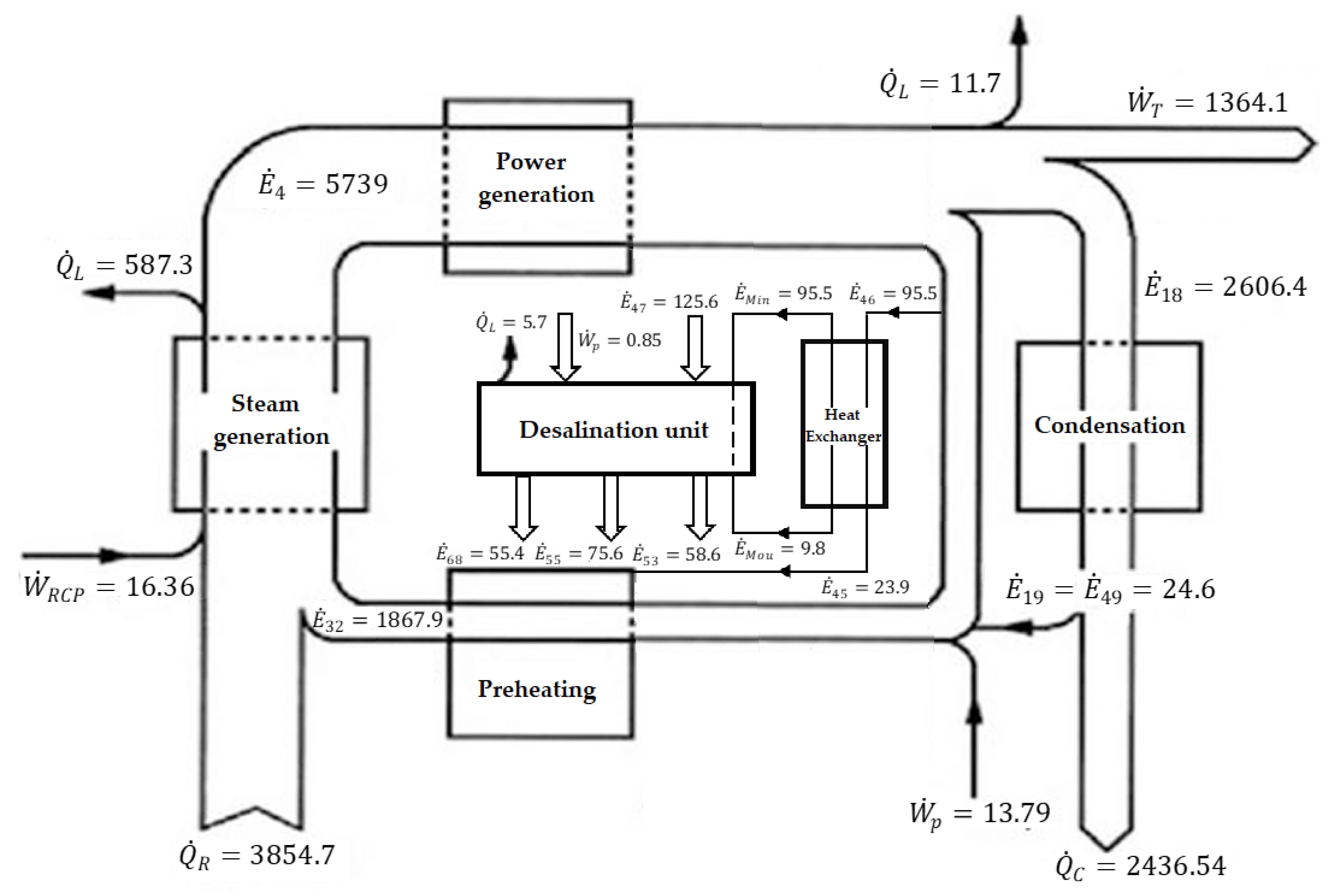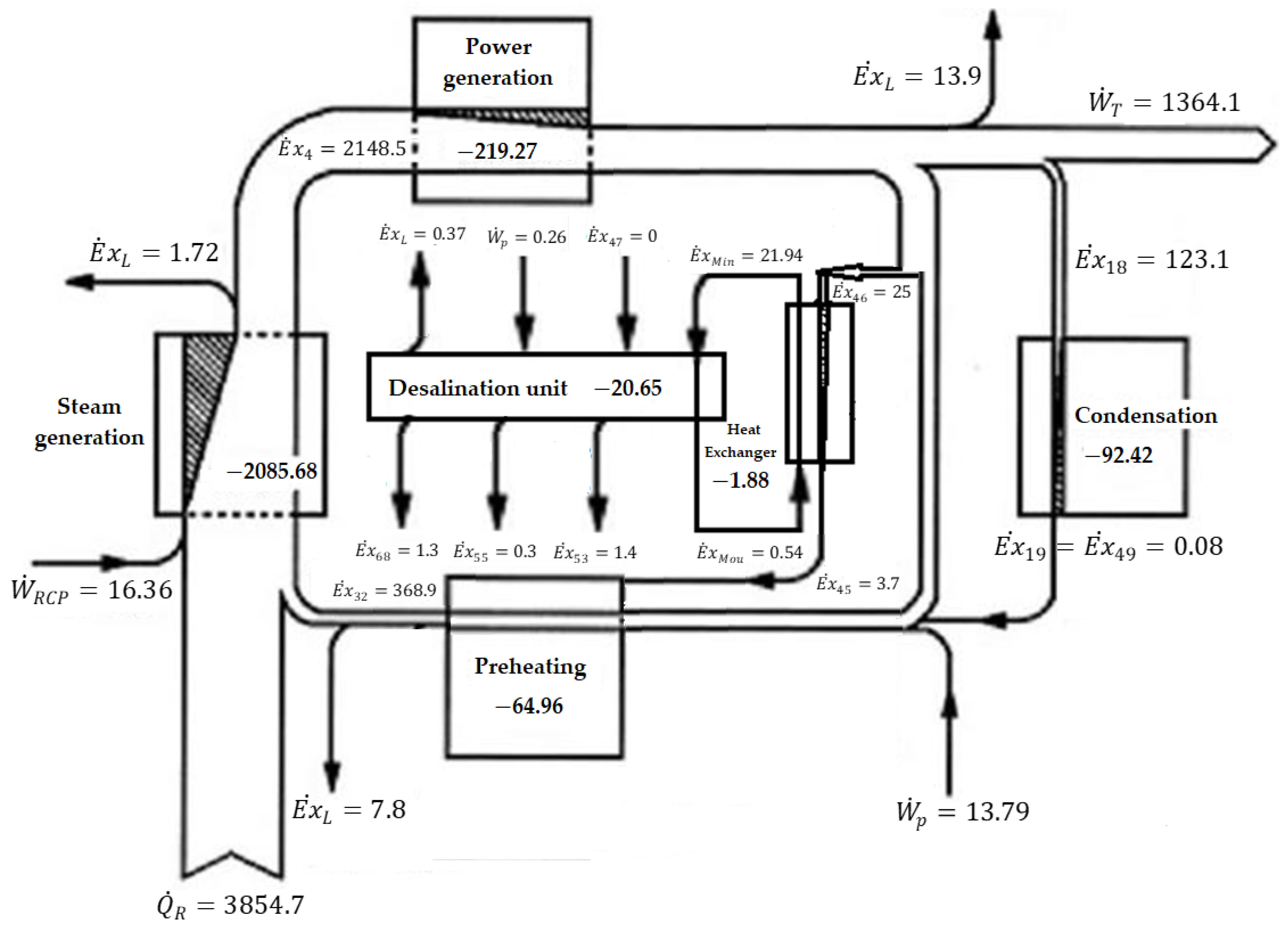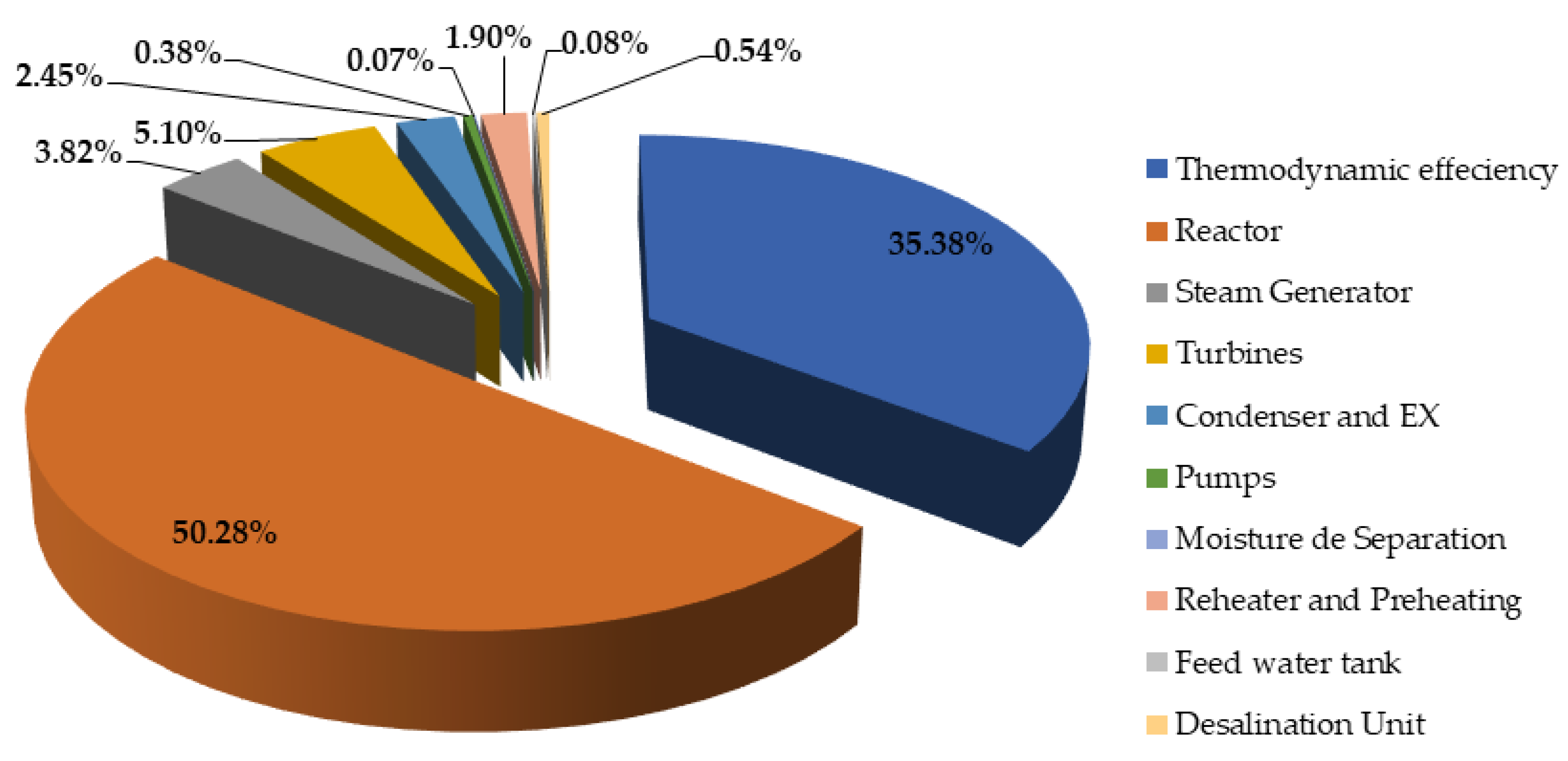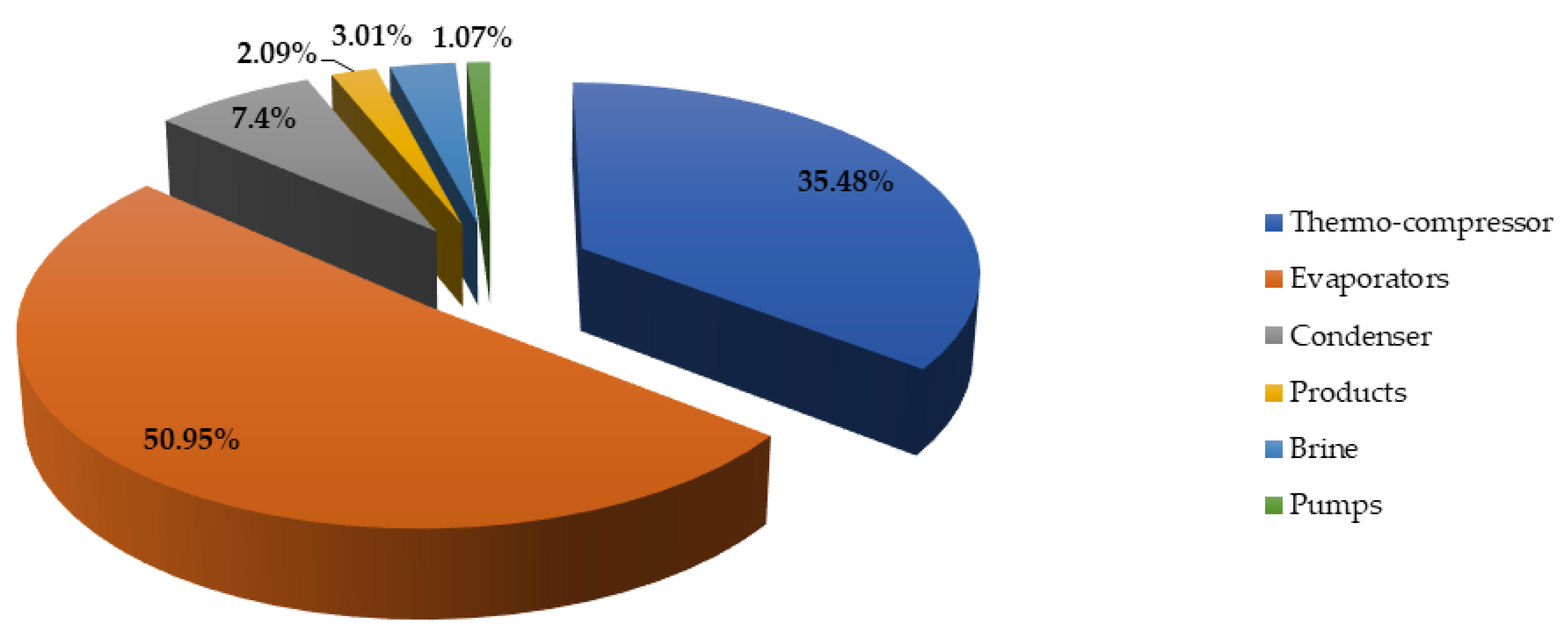1. Introduction
Many cogeneration plants for the simultaneous production of electrical and thermal energy for desalination plants still mainly use conventional fuels, such as natural gas and coal. However, the increasing environmental pollution caused by conventional fuels and the ineffectiveness and exhaustion of available fuel reserves has prompted many researchers to explore other sustainable and environmentally friendly sources of energy, such as renewable and nuclear energy. They are the most suitable and reliable candidates for industrial processes, such as desalination. Thus, nuclear energy, which avoids many of the problems associated with fossil fuels, is an efficient and advantageous option for the main desalination plants [
1,
2].
Among other clean and renewable resources, nuclear desalination is a sustainable source of energy and potable water that could assist in addressing the present issues with access to electricity and potable water. As such, it should be considered in public policy to protect the environment. However, the multiple subsystems of nuclear power plants (NPP) result in some irreversibilities and corresponding energy losses. Therefore, reducing the irreversibilities becomes a crucial duty in order to increase the amount of energy that is available in the plant. Undoubtedly, defining the irreversibility quantities in various components requires significant effort [
2,
3].
Exergy analysis is an essential diagnostic tool for energy conversion systems since it pinpoints where and how much energy is lost throughout a process. Additionally, the origins of the energy losses will be revealed. The minimum effort of separation is a crucial consideration during the design stage of thermal desalination processes in order to reduce entropy generation, which lowers freshwater costs, pollution, and greenhouse gas emissions. In addition, by reducing the entropy, the system can operate more efficiently, leading to a reduction in the amount of brine discharge into the sea [
4,
5].
Despite the significance of the electricity–water cogeneration principle, very few studies on the energetic analysis of such systems have been published. Additionally, despite having a high-performance ratio, several desalination technologies have not yet been researched. Kambiz Ansari et al. [
6,
7] performed an exergetic and exergo-economic analysis supplemented with multi-objective optimization of the coupling of a desalination plant by multi-effect thermal vapor compression distillation (MED-TVC) with a nuclear power plant with a pressurized nuclear reactor (PWR). A genetic algorithm (GA) was used to minimize the cost of system operation (cost of producing electricity and freshwater) and maximize the energy efficiency of the system. The results showed that the costs of thermodynamic inefficiencies (the cost of exergetic destruction) for the optimized system components have been reduced compared to the corresponding cost of exergetic destruction in the base scenario plant. In addition, it has been confirmed that their optimization improved the thermodynamic and economic characteristics of the system.
Khoshgoftar Manesh et al. [
8,
9] carried out a multi-objective optimization of a PWR nuclear power plant coupled to a multi-flash distillation (MSF) desalination system through GA and mixed-integer non-linear mathematical programming methods. In addition, a computer program has been developed in the MATLAB environment for a thermoeconomic analysis. The results demonstrated that the evolutionary algorithm (NSGA-II) could be systemically and elegantly applied to the PWR-MSF dual-purpose plant.
In addition, Khalid et al. [
10] described a comparative evaluation of two nuclear desalination systems. The reverse osmosis (RO) system used for desalination is coupled to a CANDU6 nuclear reactor and a fast reactor cooled with SFR sodium. Exergetic analysis was used to evaluate the cogeneration systems’ performance. The results showed that the exergetic efficiencies of the CANDU-6 and SFR systems are respectively 32.8% and 36.8%. In addition, the exergetic efficiencies of the RO process for the CANDU 6 and SFR systems are 49.2% and 36.3%, respectively. In addition, Khalid et al. [
11] presented a parametric study of the coupling of a modular helium gas turbine reactor (GT-MHR) with the RO process performed to reveal the effect of certain parameters on energy efficiency. The analysis showed that the exergy efficiency of cogeneration processes increases by 10.3% if the waste heat from the reactor is used.
Priego et al. [
12] presented a study on nuclear desalination using the SMART reactor coupled with two thermal desalination processes, multi-effect (MED) and multi-flash (MSF) distillation. The study was carried out using exergetic and thermo-economic analyses. In either case, the analyses were carried out for gain output ratios (GORs) of 5, 10, and 15. The results indicated that economic competitiveness and the feasibility of nuclear desalination using the main stream line of the reactor. In addition, the greatest quantity of water for every extraction position in the MED and MSF processes as well is produced by the gain ratio of 15.
The number of reported studies concerned with nuclear desalination in the literature is increasing. A comprehensive overview of the most recent studies on the various aspects of nuclear desalination is provided by Al-Othman et al. [
13]. The review highlighted the main advantages of this coupled technology and the principal challenges facing its development and extensive industrial use. However, despite the importance of the electricity–water cogeneration principle, until recently, few studies have been published on using exergetic analysis for such systems. In addition, some desalination technologies that exhibit high-performance ratios have not been explored yet. Hence, it is valuable to delve into this field to gain a more comprehensive understanding of current facilities and future undertakings.
In this paper, energy and exergy analysis was conducted on a multi-effect thermal vapor compression plant (ME-TVC-MED) combined with a PWR nuclear power plant based on real operational data for the simultaneous production of electricity and freshwater. A mathematical model of the PWR-ME-TVC-MED cogeneration plant was developed using the most recent and accurate correlations and developed values of the properties of seawater, including chemical exergy, which provide more novel approaches for the design and operation of the plant, leading to improved efficiency, performance, and sustainability. The model takes into account the behavior of the nuclear reactor, the thermo-vapor compression system, and the multi-effect distillation system, as well as their interactions with each other and with the environment. This approach allows for maximum efficiency and energy savings while reducing greenhouse gas emissions and water consumption compared to traditional power plants.
2. Cogeneration Plant Description
In this study, a cogeneration system based on a combined NPP and desalination plant is considered. The overall system is shown in
Figure 1 with a schematic process flow shown in
Figure 2. The energy side is the Angra (II) nuclear power plant in Brazil, while the water desalination side is based at the Al-Jubail desalination plant (ME-TVC-MED), which is located in the Kingdom of Saudi Arabia (KSA). The proposed NPP is equipped with a pressurized light-water reactor (PWR). A 3855 MW thermal reactor is used to generate the nominal power of 1300 MWe, operating under local climate conditions. The technical data of the PWR power plant are summarized in
Appendix A. The Al-Jubail desalination plant’s ME-TVC-MED consists of two Multi-Effect Distillation (MED) units equipped with thermo-vapor compressors (TVCs) integrated with a conventional MED unit to form a single entity.
Referring to
Figure 1, the NPP plant consists of three main cycles, including the primary, secondary and tertiary cycles. In the primary cycle, the four similar cooling cycles (a reactor and four steam generators, four pumps, and four pressurizers) use water as the heat transfer fluid. This circuit is always kept under pressure to prevent vaporization of the heat transfer fluid at the reactor’s operating temperature. The pressurizer is a component of the loop that maintains the pressure of the coolant loop. In the primary cycle, thermal energy is dissipated by the fission reaction of nuclear fuel at the heart of the reactor.
The cycle also includes several additional components, such as low-pressure (LP) heaters, high-pressure (HP) heaters, a feedwater tank (FWT), a water or moisture separator (MS), and a reheater (RH). The LP and HP heaters preheat water by recovering heat to increase its temperature before it enters the steam generator. The FWT stores and supplies water to the steam generator, while the MS removes any moisture from the steam to ensure its purity. The RH superheats steam before it enters the low-pressure turbine, resulting in improved overall system performance.
Figure 1 provides an overview of the position of these devices in the nuclear power plant, as well as the thermodynamic cycle for the system.
The heat generated by the fission reaction is transferred to the coolant (water). The coolant is recirculated in the steam generators and evaporates the working fluid (steam) from the second cycle. The secondary circuit is based on a Rankine cycle similar to that of most steam power plants. The steam that comes out of the steam generator is divided into two streams; one part of the outlet steam is directed to the HPT turbine, and the rest is used to heat the flows extracted from the humidity separator. The superheated steam from the pre-heater is directed to the BPT turbine. Finally, in the third circuit, the seawater cools the vapor in the condenser after it leaves the low-pressure turbine. This cooling process is necessary to guarantee all the thermodynamic processes of the installation, including the cooling of the reactor, the production of steam, and the production of electricity.
The outlet flow to the first extraction line from the BPT turbine designated by flow number 44 is divided into two flows, numbered as 46 and 14. Flow 46 is directed to an intermediate insulation loop heat exchanger (designated as EX in
Figure 1). The latent heat from flow 46 is transferred to the circulating water stream, increasing its temperature by about 5 °C. Some of the heated water then enters the expansion chamber, forming the vapor designated as Min. This vapor (Min) is utilized as the driving vapor in the first stage of the MED-TVC process. The heat exchanger (EX) is implemented to prevent direct contact between the steam from the PWR power plant and the water from the desalination plant, avoiding the risk of radioactive contamination in the freshwater. Flow 46 used to generate the driving steam for the ME-MED-TVC system is condensed in the EX and then returned to the second cycle of the PWR as flow 45.
Figure 2 illustrates a process flow diagram of the ME-TVC-MED, with the relevant operational data presented in
Appendix B. The condensates of the first effects in the two MED-TVC units are divided into two flows (
S and
Dr); the first returns to its source, while the second pass is to the product of desalinated water. The vapor generated (
D) in the first effect of each MED-TVC unit is directed to the second effect as side effect and acts as source of heat in the next effect at lower pressure and temperature. The hot brine leaving the first effect in each MED-TVC unit passes into the second effect through the brine (
B1). This iterative process is repeated through all the effects up to the final effect (
N) of each MED-TVC unit.
The second flow (Dv) is combined with the flow from the other MED-TVC unit and directed to the first effect of the MED unit to start the desalination process at a low temperature. This process is the same in the MED-TVC unit and repeated until the last effect (n) in the MED unit. The steam produced by the final effect is ultimately sent to the condenser, where it transfers its latent heat to the cooling water Mc, raising its temperature from Tsw to Tf. The remainder of this cooling water is returned to the sea, while some of it is used as feed for the various effects (Rrej).
4. Results and Discussion
The ME-TVC-MED desalination unit performance results are shown in
Table 5. The results have been validated based on a comparison with three units available in the literature [
15,
22], as illustrated in
Table 6. In this study, the thermal balance diagram of the combined PWR-ME-TVC-MED system is shown in
Figure 3 and
Figure 4. The diagram includes a total of 70 states, with the first three states located on the primary circuit of the PWR unit. The states from 4 to 60 are located along the flow stream on the secondary side piping unit of the PWR unit, while states 47 to 70 are found along the flow stream of the desalination unit at the inlet and outlet of its components. Streams 41 and 42 are located along the flow stream of the closed-loop cooling system piping unit at the inlet and outlet of the condenser. The properties of seawater are calculated using empirical correlations based on temperature and concentration at a constant atmospheric pressure.
For all the state numbers shown in
Figure 1 and
Figure 2, the reference state for the nuclear power plant is chosen as a sub-cooled liquid at an ambient pressure of
p = 1.01 bar and a temperature of 25 °C for the water/steam, and for the environmental and dead state desalination unit, these were
T = 298 K,
p = 1.01 bar and
= 39,000 ppm, which represents the intake conditions for the seawater for this analysis. Therefore,
h = 104.8374 kJ/kg and
s = 0.3661 kJ/kg.K. The results of the energy and exergy flow rates for the combined PWR and ME-TVC-MED plant are presented in
Appendix C.
Table 7 shows that the reversible (maximum) work that can be extracted from the system is 3854.7 MWth. The total thermodynamic efficiency of the PWR-ME-TVC-MED cogeneration plant was found to be 35.38%. According to the literature, the thermodynamic efficiency value of a PWR-ME-TVC-MED cogeneration plant of 1000 MWe was estimated as 33.83% [
7]. In addition, the thermal efficiencies of CANDU6-RO and SFR-RO hybrid systems are 32.8% and 36.8%, respectively [
10]. In addition, the thermodynamic efficiency of the GT-MHR-RO cogeneration plant was found to be 41% [
11]. Therefore, the cogeneration plant presented in this study has an average efficiency value among those.
In addition, the total thermodynamic efficiency of the PWR-ME-TVC-MED cogeneration was found to be 35.38%. Comparatively, a previous study of a 1000 MWe PWR-ME-TVC-MED cogeneration plant found a thermodynamic efficiency of 33.83% [
7]. Moreover, the thermal efficiencies of the CANDU6-RO and SFR-RO hybrid systems are 32.8% and 36.8% [
10], respectively. The thermodynamic efficiency of the GT-MHR-RO cogeneration plant was found to be 41% [
11]. Thus, the cogeneration plant presented in the present study has an average efficiency value among those.
The total amount of energy that is lost as a result of inefficiencies in the cogeneration system is estimated to be 64%. The overall thermodynamic efficiency of the PWR-ME-TVC-MED system is 35.38%, as reported in
Table 7. The difference between the total exergy rate produced and the total rate of exergy destruction is 0.046% for the entire system.
To address the component irreversibility in the PWR-ME-TVC-MED cogeneration system, the following measures can be taken:
Improve the efficiency of the PWR: The PWR operates by generating high-pressure steam, which is used to drive a turbine and generate electricity. The efficiency of the PWR can be improved by using advanced materials for the reactor core, optimizing the fuel assembly design, and improving the heat transfer in the steam generators.
Reduce heat losses: Heat losses occur in various components of the cogeneration plant, including the PWR, the ME unit, the TVC, and the MED unit. These losses can be minimized by improving the insulation of the components, reducing the surface area of the heat exchangers, and using advanced heat transfer fluids.
Optimize the operation of the system: The operation of the cogeneration plant can be optimized by adjusting the operating parameters of the various components to ensure that they operate at their maximum efficiency. This includes optimizing the flow rates of the fluids, adjusting the temperature and pressure of the steam and water, and minimizing the pressure drops across the components.
In addition, there are several ways to reduce heat losses in the PWR-ME-TVC-MED cogeneration plant, including:
Insulation: Insulating the plant’s pipes, tanks, and other equipment can reduce heat loss and improve energy efficiency.
Heat recovery: Implementing heat recovery systems can capture waste heat generated by the plant and use it for other processes, such as heating water or generating electricity. This can help reduce heat losses and improve the overall efficiency of the plant.
Improved maintenance: Regular maintenance and cleaning of the plant’s equipment can help ensure that it operates efficiently and reduces heat loss due to leaks, blockages, or other issues.
Upgraded equipment: Upgrading older or inefficient equipment with newer, more energy-efficient models can reduce heat losses and improve the overall efficiency of the plant.
The results estimated by the current study are presented briefly in
Table 8. Isentropic efficiencies for low- and high-pressure turbines, pumps for reactor coolant, feed water, main condensate, seawater, distillate, brine, and reject are estimated as 87.68%, 86.9%, 64.24%, 76.68%, 55.33%, 69.56%, 68.75%, 86%, and 62.35%, respectively. The simplified energy and exergy balance diagrams of the PWR-ME-TVC-MED cogeneration plant are illustrated in
Figure 3 and
Figure 4, respectively. From
Figure 3, it is obvious that the core energy makes a cycle of the steam generator, preheating unit, power generation unit, and energy flow through condensation. In addition, there is a desalination unit. In the case of the exergy balance diagram in
Figure 4, power generation, steam generation, condensation, preheating, and desalination units should be the key components.
The efficiency of the cogeneration plant and the rates of exergy destruction of the components are illustrated in
Figure 5 and
Figure 6, respectively, for the components of the desalination unit, which are more detailed than the thermodynamic calculations. It was found that the reactor core exhibited an irreversible rate of 50.28% in the installation. In addition, there are evaporators at an irreversible rate of 51% in the desalination unit.
Figure 5 displays the exergy destruction and efficiency for all components as a proportion of total exergy destruction. The main exergy destruction occurs in the reactor core due to the fission process. The transfer between the fuel rods and coolant, heat loss, and pressure drop also contribute. The high-pressure turbine has a relatively high exergy destruction rate compared to other components, due to the high fuel exergy. The steam generator, which has many components and experiences heat transfer loss, temperature differences, and pressure differences, is considered the third largest source of irreversibilities and inefficiencies in the cycle. However, the exergy destruction of other components is minor and there is a difference in the level of exergy destruction between PWR and ME-TVC-MED, due to differences in heat capacity, the inlet temperature, and the type of working fluid. Approximately 64% of the total exergy generated from the fission power in a cogeneration plant is lost. Around 54% of this loss occurs in the primary loop (core and steam generators) of the PWR due to heat losses and pressure drops in the primary circuit, while the secondary circuit components (turbines, condensers, heaters) have a loss of approximately 10%. Moreover, other components, such as desalination and EX, have a loss of 0.5%, while 66.2% of the exergy is lost in the cogeneration (PWR-MED-TVC) [
7]. In addition, 62% of the exergy is lost in the VVER NPP [
1], and 53.7% of the exergy of the fuel is diminished in the PWR NPP [
17].
The exergetic efficiency of the desalination unit was found to be 6.43%. According to the literature, the exergetic efficiency value of the desalination unit was found to be 7.58% [
24]. The results indicate that in a cogeneration plant, about 64% of the total exergy produced from fission power is lost, with about 54% of this exergy loss occurring in the primary loop (core and steam generators) of the PWR plant due to heat losses and pressure drops in the primary circuit. The secondary circuit components (turbines, condenser, heaters) have a loss of approximately 10%. Furthermore, the distillation process is extremely energy-intensive, occurring at low pressure, which increases the amount of latent heat of vaporization and the percent of exergy destruction of the component desalination unit, as shown in
Figure 6.
The results show that the highest source of irreversibilities within a desalination unit is found in the evaporators and that the thermo-compressor has a relatively high rate of exergy destruction compared to the remaining components in the system. The exergy destruction of other components is rather small. Increasing energy efficiency and reducing waste could be achieved by designing optimal heat recovery systems through various methods, such as heat exchangers or preheaters to extract the waste energy from the production line [
25,
26]. Significant efficiency improvements could also be obtained by using nanofluids, as they have been found to exhibit enhanced thermal conductivity compared to traditional fluids [
27,
28,
29,
30].
5. Conclusions
In this paper, the energy and exergy efficiency of a PWR-ME-TVC-MED cogeneration plant for the simultaneous production of electrical energy and freshwater has been analyzed. The second law was used in defining exergy to reveal contributions of the components. The most recent validated data in the literature were used to determine the thermodynamic characteristics of seawater. A mathematical model was implemented in MATLAB software and validated based on a comparison with previously published research. The following are the key findings of this investigation:
It has been shown that the nuclear reactor core is the main source of exergy loss in the cogeneration plant. Indeed, it is the worse component in the whole cogeneration system due to the irreversibility of the energy transformation. Therefore, a substantial improvement can be attained in the performance of the cogeneration plant by considering the core of the reactor components. While the thermodynamic efficiency of the PWR-ME-TVC-MED is found to be 35.38%, the irreversibilities of the core of the reactor and turbines have been calculated as 50.28% and 5.8% respectively. Low irreversibilities also exist in the components of steam generators, condensers, moisture separators, and desalination units. Additionally, in the ME-TVC-MED desalination unit, the main exergy losses occur in effects and in the thermos-compressor, which represents 85% of the total value of exergy destruction.
One way to address component irreversibility is through the use of heat exchangers, which are devices designed to transfer heat between two fluids at different temperatures. In the PWR-ME-TVC-MED cogeneration plant, heat exchangers can be used to capture the waste heat from the power generation process and use it to generate steam for the thermal desalination process. This can significantly increase the overall efficiency of the plant, as the waste heat that would otherwise be lost is put to productive use. In addition, the cogeneration plant can incorporate other technologies and strategies to improve efficiency and reduce component irreversibility. For example, the plant can use advanced materials and designs to reduce heat loss and improve the performance of key components. The plant can also use advanced control systems to optimize the operation of the various components and minimize waste.
Taking all of these conclusions into consideration, optimizing the operating conditions of the existing designs leads to the introduction of various possibilities to improve the design and performance of the cogeneration plant, based on the analysis conducted. In general, any improvement in thermodynamic performance has an economic and environmental impact. This will be published soon as the second part of the current study, using exergo-economic and exergo-environmental methodologies.
